国际物流专业英语第1单元. General View of International Logistics
- 格式:pdf
- 大小:682.15 KB
- 文档页数:16
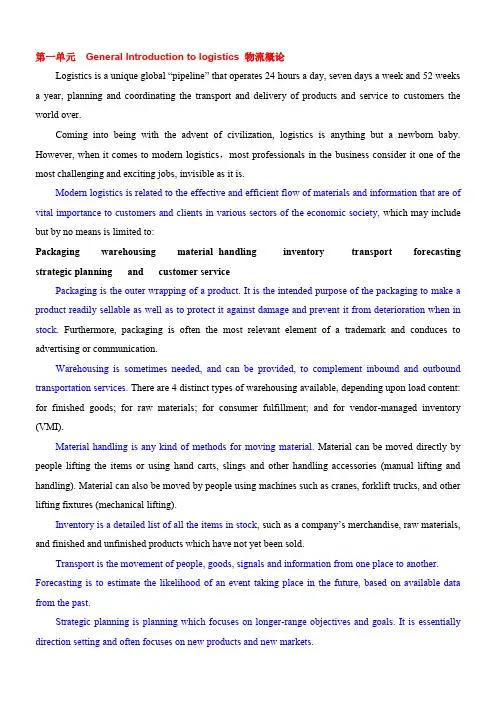
第一单元General Introduction to logistics物流概论Logistics is a unique global “pipeline” that operates 24 hours a day, seven days a week and 52 weeks a year, planning and coordinating the transport and delivery of products and service to customers the world over.Coming into being with the advent of civilization, logistics is anything but a newborn baby. However, when it comes to modern logistics,most professionals in the business consider it one of the most challenging and exciting jobs, invisible as it is.Modern logistics is related to the effective and efficient flow of materials and information that are of vital importance to customers and clients in various sectors of the economic society, which may include but by no means is limited to:Packaging warehousing material handling inventory transport forecasting strategic planning and customer servicePackaging is the outer wrapping of a product. It is the intended purpose of the packaging to make a product readily sellable as well as to protect it against damage and prevent it from deterioration when in stock.Furthermore, packaging is often the most relevant element of a trademark and conduces to advertising or communication.Warehousing is sometimes needed, and can be provided, to complement inbound and outbound transportation services. There are 4 distinct types of warehousing available, depending upon load content: for finished goods; for raw materials; for consumer fulfillment; and for vendor-managed inventory (VMI).Material handling is any kind of methods for moving material. Material can be moved directly by people lifting the items or using hand carts, slings and other handling accessories (manual lifting and handling). Material can also be moved by people using machines such as cranes, forklift trucks, and other lifting fixtures (mechanical lifting).Inventory is a detailed list of all the items in stock,such as a company’s merchandise, raw materials, and finished and unfinished products which have not yet been sold.Transport is the movement of people, goods, signals and information from one place to another. Forecasting is to estimate the likelihood of an event taking place in the future, based on available data from the past.Strategic planning is planning which focuses on longer-range objectives and goals. It is essentially direction setting and often focuses on new products and new markets.Customer service is the set of behaviors that a business undertakes during its interaction with its customers. It can also refer to a specific person or desk, which is set up to provide general assistance to customers.A systematic definition of logistics is supplied by the Council of Logistics Management: “Logistics is that part of the supply chain process that plans, implements and controls the efficient, effective flow and storage of goods, service and related information form the point of origin to the point of consumption to meet customers’ requirements.” Although this definition fails to incorporate all specific terms used in the study of logistics, it does reflect the need for total movement management form point of material procurement to location of finished product distribution第二单元An Important Factor 一个重要因素It is universally acknowledged that products are of two kinds, products for customers and products for industrial use.As industrial products are not the key factors in planning a physical distribution strategy, they will not be mentioned in this text.An important characteristic of any product is its availability at the place where a customer wishes to consume it. And this is what logistics is chiefly concerned with. Products are of any value when and only when they are moved to the right place where it is available to the customer. Thus, we should make an analysis of products, depending on who uses them and how they are used.Consumer products are those that are directed to ultimate consumers.According to the three different ways in which consumers select goods and services and where they buy them, consumer products can be put into three categories: convenience products, shopping products, and specialty products.Convenience products are those goods and services that consumers purchase frequently, immediately, and with little comparative shopping. Typical products are banking services, tobacco item, and many foodstuffs. These products generally require wide distribution through many outlets. Distribution costs are typically high but are more than justified by the increased sales potential that is brought about by this wide and extensive distribution. Customer service levels, as expressed in terms of product availability and accessibility, must be high to encourage any reasonable degree of customer patronage for the products.Shopping products are those for which consumers are willing to seed and compare: comparing in many locations the price, quality, and performance, and making a purchase only after careful deliberation. Typical products in this category are fashion clothes, automobiles, home furnishings, and medical care. Because of the customer’s willingnes s to shop around, an individual supplier may stock goods or offer services in only a few outlets in a given market area. Distribution costs for such suppliers aresomewhat lower than for convenience products, and product distribution need not be as widespread.Specialty products are those for which buyers are willing to expend a substantial effort and often to wait a significant amount of time in order to acquire them. Buyers seek out particular types and brands of goods and services. Examples can be any type of goods ranging from fine foods to custom-made automobiles or a service such as management consulting advice. Because buyers insist on particular brands, distribution is centralized and customer service levels are not as high as those for convenience and shopping products. Physical distribution costs can be the lowest of any product category. Because of this, many firms will attempt to create brand preference for their product line.第三单元Transportation 运输Transportation is a vital component in the design and management of logistics systems. It may account for one-third to two-thirds of total logistics costs. The choices available to the users typically include the five major transport modes (air, truck, rail, water, and pipe) and their combinations. Users may hire the services or own the means of transportation.Transport services are best described by their cost and performance characteristics. These distinguish one transport service from another, and it is what a user buys from the transportation system. The cost characteristics vary from one mode to another and determine their rate structures. Rates are based primarily on three factors ---- distance, shipment size, and competition. On the other hand, carrier performance is based on the extent of shipment handling at terminals and inherent speed of the carrier. It is adequately described in terms of average transit time, transit-time variability, and loss and damage.Cost allocation is one of the factors that affect pricing. The shipper’s perspective about it is important, though it is chiefly something that the carriers should pay attention to.One kind of cost is what is called variable costs. They are those costs that change in a predictable, direct manner in relation to some level of activity during a time period. Variable costs can be avoided only by not operating the vehicle. Aside form exceptional circumstances, transport rates must at least cover variable costs. The variable category includes direct carrier costs associated with movement of each load. These expenses are generally measured as a cost per mile or per unit of weight. Typical cost component s in this category include labor, fuel and maintenance. On a per mile basis, truck load carrier’s variable costs range from $0.75 to $1.50 per vehicle mile. As explained in any elementary economics text, it is not possible for any carrier to charge below its variable cost and expect to remain in business.International transportation is an area of growing interest and concern to the logistician. The transportation equipment is the same as that used domestically, with the exception that certain elements ofthe transport system have become more important. For example, containerization is popular in international movement. The user of the international transportation system may feel overwhelmed by the increased documentation, by differences in carrier liability, by various customs procedures and the use of foreign trade zones. Fortunately, there exist middlemen, agents, freight forwarders, and brokers to assist the shipper with international movement.第四单元Logistics Strategy 物流战略Inventory is viewed as playing a role in the value-added process. This does not mean the more you have in the form of inventory, the richer you are. If you keep an overstock of the inventory, expenses will incur not only in warehousing, but also in many aspects, such as the capital cost and the interest accruing on it, taxes, insurance, obsolescence cost and storage cost.On the one hand, capital cost increases with the lot size. On the other hand, the interest accrues on the capital invested in the carrying inventory, which is, in many cases, computed according to the prime interest rate or a specified rate pegged to the prime interest. The logic behind it is that the cash to replace capital invested in inventory can be purchased in the money market.In many countries, taxes are levied on the average inventory level on a specific day of the year.Insurance cost is a direct levy normally based on estimated risk or exposure over time.Obsolescence means the deterioration of product in storage which is not covered by insurance.The storage cost incurs in respect of product holding, whether you store the goods in a public warehouse, rented private warehouse or a warehouse you own yourself. The cost, which can well amount to over 37% of the total logistics cost, results in the necessity of making plans for inventory.The plan should be able to answer three basic questions: when to order, how much to order and inventory control procedures.For the time being we are concerned only with the question of how much to order. The lot sizing concept balances the cost of maintaining inventories against the cost of ordering. The key to understanding the relationship is to remember that average inventory is equal to one-half the order quantity. The larger the order quantity, the fewer orders required per planning period and, consequently, the lower the total ordering cost. Lot quantity formulations identify the precise quantities at which the annual combined total cost of ordering and maintenance is lowest for a given sales volume.In the figure, the point where the curve of dashes crosses with the straight is the point for most economical number of orders.第五单元Packaging 包装Packaging can be divided into industrial packaging and consumer packaging. Generally speaking, consumer packaging, which mainly aims at containing the goods, promoting the sale of it and facilitating use of it, is of little value to logistics operation. But industrial packaging has a significant impact on the cost and productivity of logistics.Industrial packaging should perform the following functions to meet integrated logistics requirements.First, it should protect the goods from damage during handling, storing and transportation. Damage caused by vibration, impact, puncture or compression can happen whenever a package is being transported. Hence, package design and material must combine to achieve the desired level of protection without incurring the expense of over protection. It is possible to design a package that has the correct material content but does not provide a necessary protection. Arriving at a satisfactory solution involves defining the degree of allowable damage in terms of expected overall conditions (because in most cases, the cost of absolute protection will be prohibitive) and then isolating a combination of design and material capable of meeting those specifications.Second, it should promote logistical efficiency. Packaging affects not only marketing and production but also integrated logistics activities. For example, the size, shape and type of packaging material influence the type and amount of material handling equipment as well as how goods are stored in the warehouse. Likewise, package size and shape affects loading, unloading, and the transporting of a product. The easier it is to handle a product, the lower the transportation rate. Hence, it the package is designed for efficient logistical processing, overall system performance will benefit.T he third important logistical packaging function is communication or information transfer. To identify package contents for receiving, order selection and shipment verification, etc., is the most obvious communication role of packaging. Typical information includes manufacturer, product, container type, count, and Universal Product Code (UPC) number. Ease of package tracking is also important. Effective internal operation and a growing number of customers require that product be tracked as it moves through the logistics channel. This can be realized by the extensive use of Radio Frequency Identification (RFI), a computer chip embedded in the package, container, or vehicle to allow the container and contents to be scanned and verified as it passes checkpoints in the distribution facility and transportation gateway. The final communication role of logistics packaging is to provide instructions as to how to handle the cargo and how to prevent possible damage. For instance, if the product is potentially dangerous, such as fireworks and table tennis balls, the packaging or accompanying material should provide instructions for avoiding moisture, vibration and heating, etc., as the case may be.第六单元Purchasing采购Every organization, whether it is a manufacturer, wholesaler, or retailer, buys materials, services, and supplies from outside suppliers to support its operation. For most organizations, supply management means purchasing. In many firms, purchasing has been seen as a clerical activity. However, the emergence of the supply chain management concept has enlightened many managers about the strategic role played by purchasing.Purchasing contributes to the firm’s efficiency and effectiveness in many ways. First, it helps to determine a firm’s cost structure. Purchased goods and services are one of the largest elements of costs for many firms. In the average manufacturing firm in North America, purchased goods and services account for approximately 55 cents of every sales dollar. By way of contrast, the average expense of direct labor in the manufacturing process accounts for only about 10 cents of every sales dollar. While the percentage spent on purchased inputs does vary considerably across organizations, it is clear that the potential savings form strategic management of purchasing are considerable. Therefore, managers with good negotiating shills and strong relationships with suppliers can save their organizations large sums relative to the competition. And identifying the right production equipment and buying it at a good price can create competitive cost advantages that last for many years.Second, good purchasing practices avoid operational problems. Stockouts of raw materials or component parts can shut down a production plant. The quality of finished goods and services is obviously dependent upon the quality of the materials and parts used in producing those items. If poor-quality components and materials are used, then the final product will not meet customer’s quality standards. While avoiding these problems may not lead to operational effectiveness, operational effectiveness is impossible if these problems arise.Without effective purchasing practices, operations in a firm may be disrupted, customer service levels may fall, and long-term customer relationship may be damaged. Before any product can be manufactured, supplies meeting certain conditions must be available. Fortunately, progressive managers have recognized these potential contributions of purchasing and have taken the necessary steps to ensure results. The most important single step in successful organizations has been the elevation to top executive status of the purchasing manager. This, coupled with high-caliber staff and the appropriate authority and responsibility, has resulted in an exciting and fruitful realization of the potential of the purchasing contribution.第七单元Information信息Information is crucial to the performance of a supply chain because it provides the facts that supply chain managers use to make decisions. Without information, a manager will not know what customers want, how much inventory is in stock and when more products should be produced and shipped. In short, without information, a manager can only make decisions blindly.Supply chain managers use information to make many important decisions relating to each of the supply chain drivers. Setting inventory levels requires downstream information form customers on demand, upstream information from suppliers on availability, and information on current inventory levels, costs, and margins. Determining transportation policies requires information on customers, suppliers, routes, costs, times, and quantities to be shipped. Facility decisions require information on demand and suppliers, as well as information on capacities, revenues, and costs within the company.Managers must understand how information is gathered and analyzed. This is where information technology comes into play. Information technology (IT) consists of the hardware and software used throughout a supply chain to gather and analyze information. IT serves as the eyes and ears of management in a supply chain, capturing and delivering the information necessary to make a good decision. For instance, an IT system at a personal computer (PC) manufacturer may tell a manager how many Pentium IV chips are in stock to put into newly made PCs. IT is also used to analyze the information and recommend an action. In this role, a manager at a PC manufacturer can take the number of chips in inventory, look at demand forecast, and determine whether to order more chips form Intel.第八单元Supply Chain供应链Supply chain is defined as a network composed of factories, suppliers, retailers, etc, that supply to each other raw material, components, products and service. Supply chain management means the design planning and control of the goods and money with a view to strengthening competitiveness.While logistics is not a new thing, supply chain management is comparatively a new idea it was first put forward in the 1980s on the basis of experience and lessons from the past practice.Ford Motor Company is a case in point Henry Ford envisaged a totally self-sufficient industrial empire. In River Rouge just southwest of Detroit, Ford developed a huge manufacturing complex that included an inland port and an intricate network of rail and road transportation. Ford’s objective was control. To achieve this goal, he set out to develop the world’s first complex vertically integrated firm.To ensure a reliable supply of materials Ford invested in coalmines, iron-ore deposits, timberlands, glass factories, and even land to grow soybeans used to manufacture paint. Ford’s commitment to self-sufficiency extended’ to buying 2.5 million acres in Brazil to develop a rubber plantation he calledFordlandia. Ford’s imagination knew no bound. He even ordered a huge quantity of potatoes from South America to explore the possibility of extracting alcohol in, of course, one of his laboratories, hoping that alcohol would one day replace gasoline.Ford’s desire for control went beyond material and components. To transport materials to River Rouge and finished product to dealers he invested in railroads, trucks and both Great Lakes and ocean vessels. The idea was to control all aspects of inventory moving from a network of over forty manufacturing, service, and assembly plants throughout the United States, Canada, Australia, New Zealand, the Unites Kingdom, and South Africa to dealers throughout the globe.This was clearly one of the most ambitious vertical integration schemes, and Ford found he needed help. At the peak of Ford’s vertical extension the firm faced economic, regulatory, and labor union barriers that eventually required products and services to be provided by a network of independent suppliers. The key to effective marketing was finally found by developing g strong network of independent dealers. As time passed, Ford discovered that specialized, firms could perform most essential work as well as or better than his own bureaucracy. In fact, these specialists often outperformed Ford’s own units with respect to quality and cost. Entrepreneurial firms soon became contributors to Ford’s network. Over time, the Ford strategy shifted from ownership-based control to one of orchestrating channel relationships. The financial resources at Ford were shifted to developing and maintaining core manufacturing competencies Ford found out that in the final analysis, no firm can be self-sufficient.In the later part of the 20th century, Ford Motor Company began to rely on specialist logistics companies for logistics service.Ford Fleet, for example, has been outsourcing its logistics from Exel, a world class leader in supply chain solutions, since 1986, as Ford Fleet found its transport cost was rising while profit diminished.The problem with Ford at that time was that it had come under increasing pressure from industry over awareness. Ford’s purpose was to cut costs from the global supplier base, while expanding its role as a consumer organization.With Exel’s support, Ford has realized significant benefits throughout its corporate sales divisions. This has included a 19% reduction in transportation costs over a period of four years. Proactive fleet management has produced a six-figure saving and has increased the overall utilization and therefore the in-service potential of the demonstration fleet. Equipping drivers with mobile phones has led to a reduction in aborted journeys from 7% to 2%. This produces a saving in terms of driver time and delivered miles on the vehicle, The financial savings for Ford from the efficiency actions taken by Exelhave been complemented by an increase in the service levels to Ford’s customers. Exel is continuously improving the service offering through constant evaluation, development and innovation.第九单元Maritime Transportation 海上运输Maritime shipping is an important link in international logistics service. There are two types of shipping markets, the liner market and the tramp market.A far greater amount of cargo is shipped by bulk carriers, which can be chartered on the tramp market on a time basis or on voyage basis. A considerable amount of cargo is shipped by huge container ships running on fixed lines around the world. As far as outbound flow of products from manufacturers is concerned, container ships are usually most frequently used.When you need to send cargo to a buyer overseas according to a sales contract, you must, after you have completed the necessary documentation for insurance, cargo survey, etc. as per the clauses in the Letter of Credit, book space on a ship either by yourself or via a freight forwarder. If you decide to book the space yourself, you can go to a shipping company or simply go on the Internet, find the website of the carrier you want, and book the space there. In either case, you have to fill up what is commonly referred to as Booking Note, which is of the ten copies designed for use in different related sectors in the shipping procedures, such as the cargo owners, the ship agent, the container yard, the port authorities for the port dues and port charges, the ship, the dock, and the Customs House.Then, when the shipping company accepts your space-booking, you will receive a Container Load Plan in due course as shown in Figure 9-1. The Container Load Plan is of five copies which will be given to the terminal, the carrier, the ship agent, the shipper and the party that load your container on board the ship.At the same time, the shipping company will make a stowage plan for the ship, which decides the specific location for each container in the holds, taking into consideration of the weight, its destination and the ship’s specifications.When your cargo is stuffed into a container, it is hauled to the container yard (CY) to be loaded on board the ship according to the stowage plan. When this is done, the First Mate would sign a Mate’s Receipt (Figure 9_2). This document is very important, as the shipping company will issue the bill of Lading according to the statements on it.You can now take the Bill of Lading (Figure 9-3) (three originals and, as sometimes you can request, three copies) together with all the documents required by the Letter of Credit to the negotiating bank to exchange for money from the buyer.第十单元Third-Party Logistics第三方物流One of the major functions of Third-Party Logistics TPL companies is known as supply chain management, the process that integrates co-ordinates and controls the movement of materials, finished inventory and related information from suppliers through companies to meet consumer requirements.The objectives of supply chain management are to reduce overall costs, minimize lead time, minimize inventory levels and cost, improve service level and streamline goods and information flows. TPL functions as the expertise in providing client with professional operation to achieve the above-mentioned goals. With the increasing competition in the market, the service providers have to obtain a solid footing in the industry by providing differentiated products such as consolidation warehouses, consistent customer relationships, upstream management and visibility, innovation, global network, etc.It has become a global trend for TPL to apply technology to achieve an integrated process. Adopting sophisticated technologies is not just about reducing labor costs, but also about greater visibility, improving customer service and using information more effectively to figure out things like trends and supplier performance.One of the value adding services provided by TPL could be its IT system. Purchase orders will be placed online and licked up online by vendors. They will then produce the merchandise that will then be passed to the logistics company. It is a kind of system that will reduce the order-to-shelf time even further and lead to essential cost efficiencies.Most TPL companies tailor their requirements of their customers, such as providing global reach for a client. Take Maersk Logistics and Federated for example. Being Federated’s global one-stop-shop provider for all ocean-going shipments, Maersk Logistics works with Federated from the moment one of its divisions places an order right through to the company’s distribution center.Local service is another selling point of TPL supply chain management.Efficient trucking service, computerized warehouse system together with customized operation are essential to upgrading the service level of TPL company.All in all, while supply chain management of TPL Company, a key for a continued growth of international trade, has large potentiality for further development, it has a long way to go before reaping a greater success.。
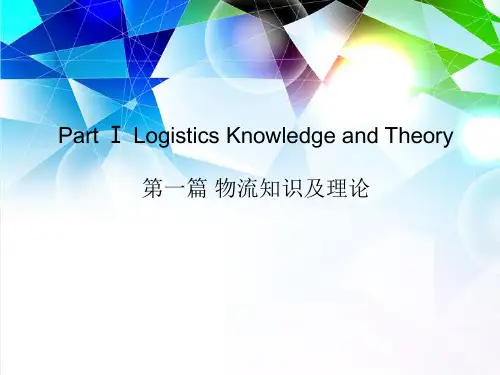
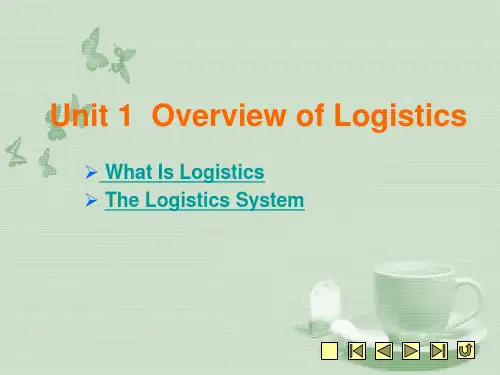
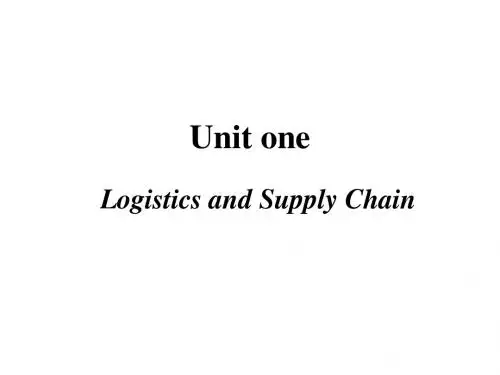

ReferencesUnit 1 An Introduction to Business LogisticsPart II. Exercises for Dialogue 1Answer the following questions according to the dialogue.1.Logistics means to supply the right product at the right time in theright quantity in the right condition at the right place for the right customer at the right price.2.It includes the procurement, maintainance, distribution andreplacement of personnel and material.3.These two concepts are the same meanings. Logistics is generalmeaning and includes military definition and business definition.Business logistics stresses special term on a trade or business. Exercises for Dialogue 21.(Opening)2.(Opening)Part III. Practical ReadingsExercises for Text 1I. Answer the following questions:1. Business logistics means to be defined as a business-planning framework for the management of material, service, information and capital flows.2. Business logistics involves the following activities: demand forecasting,procurement, materials handling, packaging, warehouse and inventory management, ordering processing, logistics communications, transport, customer service and so on.3. The role of logistics is to maintain the balance between the minute details and the main elements involved in a product.II.1.商务物流管理有不同版本的不同定义 2 必要资源的利用3. 逆向货物的搬运4. 人员和材料的补充5. 复杂信息6. 现代的商业环境7. 需求预测8. 设施场地选择9. 公司最重要的财富10. 公司战略抉择走势评定III. definitions—heart---output---service---strategyIV. 1. 这一非常宽广的物流观点把单一的供应链与贸易公司的方方面面整合在一起。
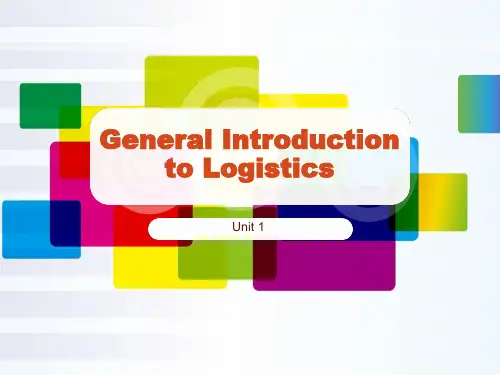
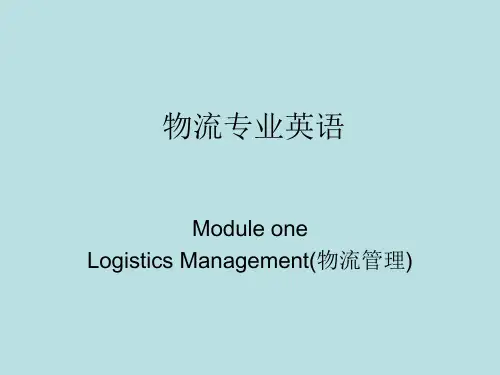
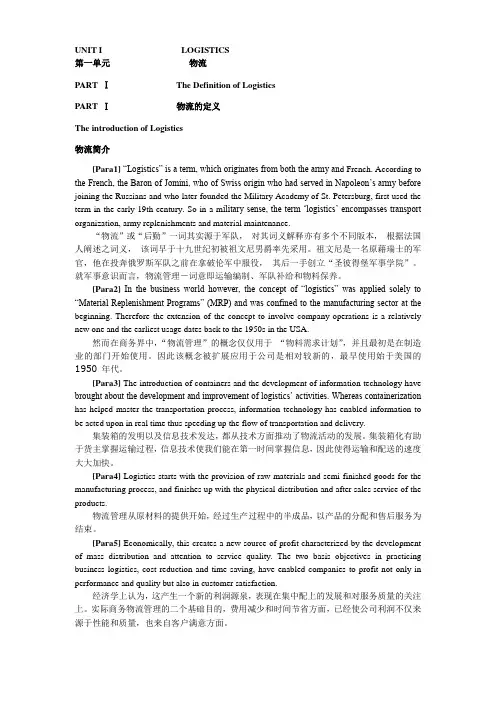
UNIT I LOGISTICS第一单元物流PART ⅠThe Definition of LogisticsPART Ⅰ物流的定义The introduction of Logistics物流简介[Para1]“Logistics” is a term, which originates from both the army an d French. According to the French, the Baron of Jomini, who of Swiss origin who had served in Napoleon’s army before joining the Russians and who later founded the Military Academy of St. Petersburg, first used the term in the early 19th century. So in a m ilitary sense, the term ‘logistics’ encompasses transport organization, army replenishments and material maintenance.“物流”或“后勤”一词其实源于军队,对其词义解释亦有多个不同版本,根据法国人阐述之词义,该词早于十九世纪初被祖文尼男爵率先采用。
祖文尼是一名原藉瑞士的军官,他在投奔俄罗斯军队之前在拿破伦军中服役,其后一手创立“圣彼得堡军事学院”。
就军事意识而言,物流管理―词意即运输编制、军队补给和物料保养。
[Para2] In the business world however, the concept of “logistics” was applied solely to “Material Replenishment Programs” (MRP) and was confined to the manufacturing sector at the beginning. Therefore the extension of the concept to involve company operations is a relatively new one and the earliest usage dates back to the 1950s in the USA.然而在商务界中,“物流管理”的概念仅仅用于“物料需求计划”,并且最初是在制造业的部门开始使用。


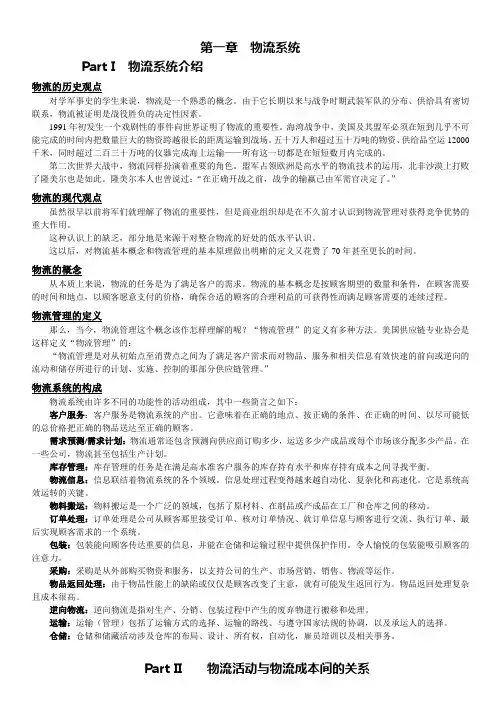
第一章物流系统Part I 物流系统介绍物流的历史观点对学军事史的学生来说,物流是一个熟悉的概念。
由于它长期以来与战争时期武装军队的分布、供给具有密切联系,物流被证明是战役胜负的决定性因素。
1991年初发生一个戏剧性的事件向世界证明了物流的重要性。
海湾战争中,美国及其盟军必须在短到几乎不可能完成的时间内把数量巨大的物资跨越很长的距离运输到战场。
五十万人和超过五十万吨的物资、供给品空运12000千米,同时超过二百三十万吨的仪器完成海上运输——所有这一切都是在短短数月内完成的。
第二次世界大战中,物流同样扮演着重要的角色。
盟军占领欧洲是高水平的物流技术的运用,北非沙漠上打败了隆美尔也是如此。
隆美尔本人也曾说过:“在正确开战之前,战争的输赢已由军需官决定了。
”物流的现代观点虽然很早以前将军们就理解了物流的重要性,但是商业组织却是在不久前才认识到物流管理对获得竞争优势的重大作用。
这种认识上的缺乏,部分地是来源于对整合物流的好处的低水平认识。
这以后,对物流基本概念和物流管理的基本原理做出明晰的定义又花费了70年甚至更长的时间。
物流的概念从本质上来说,物流的任务是为了满足客户的需求。
物流的基本概念是按顾客期望的数量和条件,在顾客需要的时间和地点,以顾客愿意支付的价格,确保合适的顾客的合理利益的可获得性而满足顾客需要的连续过程。
物流管理的定义那么,当今,物流管理这个概念该作怎样理解的呢?“物流管理”的定义有多种方法。
美国供应链专业协会是这样定义“物流管理”的:“物流管理是对从初始点至消费点之间为了满足客户需求而对物品、服务和相关信息有效快速的前向或逆向的流动和储存所进行的计划、实施、控制的那部分供应链管理。
”物流系统的构成物流系统由许多不同的功能性的活动组成,其中一些简言之如下:客户服务:客户服务是物流系统的产出。
它意味着在正确的地点、按正确的条件、在正确的时间、以尽可能低的总价格把正确的物品送达至正确的顾客。
国际货代英语完整讲义Unit1InternationalTrade 国际货运代理专业英语 Unit 1 International Trade英文原文:International trade is the exchange of capital, goods, and services across international borders or territories.注释:exchange: 交换,汇兑 (另外常用的一个短语:foreign exchange: 外汇)border: 边(界, 缘, 境); 界线 territory: 领土, 领地, 版图, 地区, 活动范围中文意思:国际贸易是指跨越各国国境或领土的资本、货物和服务的交换活动。
2、国际贸易重要性的表现英文原文:In most countries, it represents a significant share of gross domestic product (GDP).注释:represent: 表现, 表示, 描绘, 讲述, 代表, 象征 significant: 重要的, 重大的, 值得注意的 share: 份额 gross domestic product: 国内生产总值中文意思:在大多数国家,国际贸易占国内生产总值很大的比重。
英文原文:While international trade has been present throughout much of history, its economic, social, and political importance has been on the rise in recent centuries.注释:throughout: 遍及,贯穿 economic: 经济(上)的,经济学的 social: 社会的,社会上的 political: 政治上的,政治的 importance: 重要(性),重要方面(意义)on the rise: 在上涨,在增长 recent: 近来的 century: 世纪中文意思:国际贸易在整个历史发展过程中也得到了体现,国际贸易在经济、社会、政治等方面的重要性在近几个世纪的发展中不断增长。
第一单元General Introduction to logistics物流概论Logistics is a unique global “pipeline” that operates 24 hours a day, seven days a week and 52 weeks a year, planning and coordinating the transport and delivery of products and service to customers the world over.Coming into being with the advent of civilization, logistics is anything but a newborn baby. However, when it comes to modern logistics,most professionals in the business consider it one of the most challenging and exciting jobs, invisible as it is.Modern logistics is related to the effective and efficient flow of materials and information that are of vital importance to customers and clients in various sectors of the economic society, which may include but by no means is limited to:Packaging warehousing material handling inventory transport forecasting strategic planning and customer servicePackaging is the outer wrapping of a product. It is the intended purpose of the packaging to make a product readily sellable as well as to protect it against damage and prevent it from deterioration when in stock.Furthermore, packaging is often the most relevant element of a trademark and conduces to advertising or communication.Warehousing is sometimes needed, and can be provided, to complement inbound and outbound transportation services. There are 4 distinct types of warehousing available, depending upon load content: for finished goods; for raw materials; for consumer fulfillment; and for vendor-managed inventory (VMI).Material handling is any kind of methods for moving material. Material can be moved directly by people lifting the items or using hand carts, slings and other handling accessories (manual lifting and handling). Material can also be moved by people using machines such as cranes, forklift trucks, and other lifting fixtures (mechanical lifting).Inventory is a detailed list of all the items in stock,such as a company’s merchandise, raw materials, and finished and unfinished products which have not yet been sold.Transport is the movement of people, goods, signals and information from one place to another. Forecasting is to estimate the likelihood of an event taking place in the future, based on available data from the past.Strategic planning is planning which focuses on longer-range objectives and goals. It is essentially direction setting and often focuses on new products and new markets.Customer service is the set of behaviors that a business undertakes during its interaction with its customers. It can also refer to a specific person or desk, which is set up to provide general assistance to customers.A systematic definition of logistics is supplied by the Council of Logistics Management: “Logistics is that part of the supply chain process that plans, implements and controls the efficient, effective flow and storage of goods, service and related information form the point of origin to the point of consumption to meet customers’ requirements.” Although this definition fails to incorporate all specific terms used in the study of logistics, it does reflect the need for total movement management form point of material procurement to location of finished product distribution第二单元An Important Factor 一个重要因素It is universally acknowledged that products are of two kinds, products for customers and products for industrial use.As industrial products are not the key factors in planning a physical distribution strategy, they will not be mentioned in this text.An important characteristic of any product is its availability at the place where a customer wishes to consume it. And this is what logistics is chiefly concerned with. Products are of any value when and only when they are moved to the right place where it is available to the customer. Thus, we should make an analysis of products, depending on who uses them and how they are used.Consumer products are those that are directed to ultimate consumers.According to the three different ways in which consumers select goods and services and where they buy them, consumer products can be put into three categories: convenience products, shopping products, and specialty products.Convenience products are those goods and services that consumers purchase frequently, immediately, and with little comparative shopping. Typical products are banking services, tobacco item, and many foodstuffs. These products generally require wide distribution through many outlets. Distribution costs are typically high but are more than justified by the increased sales potential that is brought about by this wide and extensive distribution. Customer service levels, as expressed in terms of product availability and accessibility, must be high to encourage any reasonable degree of customer patronage for the products.Shopping products are those for which consumers are willing to seed and compare: comparing in many locations the price, quality, and performance, and making a purchase only after careful deliberation. Typical products in this category are fashion clothes, automobiles, home furnishings, and medical care. Because of the customer’s willingnes s to shop around, an individual supplier may stock goods or offer services in only a few outlets in a given market area. Distribution costs for such suppliers aresomewhat lower than for convenience products, and product distribution need not be as widespread.Specialty products are those for which buyers are willing to expend a substantial effort and often to wait a significant amount of time in order to acquire them. Buyers seek out particular types and brands of goods and services. Examples can be any type of goods ranging from fine foods to custom-made automobiles or a service such as management consulting advice. Because buyers insist on particular brands, distribution is centralized and customer service levels are not as high as those for convenience and shopping products. Physical distribution costs can be the lowest of any product category. Because of this, many firms will attempt to create brand preference for their product line.第三单元Transportation 运输Transportation is a vital component in the design and management of logistics systems. It may account for one-third to two-thirds of total logistics costs. The choices available to the users typically include the five major transport modes (air, truck, rail, water, and pipe) and their combinations. Users may hire the services or own the means of transportation.Transport services are best described by their cost and performance characteristics. These distinguish one transport service from another, and it is what a user buys from the transportation system. The cost characteristics vary from one mode to another and determine their rate structures. Rates are based primarily on three factors ---- distance, shipment size, and competition. On the other hand, carrier performance is based on the extent of shipment handling at terminals and inherent speed of the carrier. It is adequately described in terms of average transit time, transit-time variability, and loss and damage.Cost allocation is one of the factors that affect pricing. The shipper’s perspective about it is important, though it is chiefly something that the carriers should pay attention to.One kind of cost is what is called variable costs. They are those costs that change in a predictable, direct manner in relation to some level of activity during a time period. Variable costs can be avoided only by not operating the vehicle. Aside form exceptional circumstances, transport rates must at least cover variable costs. The variable category includes direct carrier costs associated with movement of each load. These expenses are generally measured as a cost per mile or per unit of weight. Typical cost component s in this category include labor, fuel and maintenance. On a per mile basis, truck load carrier’s variable costs range from $0.75 to $1.50 per vehicle mile. As explained in any elementary economics text, it is not possible for any carrier to charge below its variable cost and expect to remain in business.International transportation is an area of growing interest and concern to the logistician. The transportation equipment is the same as that used domestically, with the exception that certain elements ofthe transport system have become more important. For example, containerization is popular in international movement. The user of the international transportation system may feel overwhelmed by the increased documentation, by differences in carrier liability, by various customs procedures and the use of foreign trade zones. Fortunately, there exist middlemen, agents, freight forwarders, and brokers to assist the shipper with international movement.第四单元Logistics Strategy 物流战略Inventory is viewed as playing a role in the value-added process. This does not mean the more you have in the form of inventory, the richer you are. If you keep an overstock of the inventory, expenses will incur not only in warehousing, but also in many aspects, such as the capital cost and the interest accruing on it, taxes, insurance, obsolescence cost and storage cost.On the one hand, capital cost increases with the lot size. On the other hand, the interest accrues on the capital invested in the carrying inventory, which is, in many cases, computed according to the prime interest rate or a specified rate pegged to the prime interest. The logic behind it is that the cash to replace capital invested in inventory can be purchased in the money market.In many countries, taxes are levied on the average inventory level on a specific day of the year.Insurance cost is a direct levy normally based on estimated risk or exposure over time.Obsolescence means the deterioration of product in storage which is not covered by insurance.The storage cost incurs in respect of product holding, whether you store the goods in a public warehouse, rented private warehouse or a warehouse you own yourself. The cost, which can well amount to over 37% of the total logistics cost, results in the necessity of making plans for inventory.The plan should be able to answer three basic questions: when to order, how much to order and inventory control procedures.For the time being we are concerned only with the question of how much to order. The lot sizing concept balances the cost of maintaining inventories against the cost of ordering. The key to understanding the relationship is to remember that average inventory is equal to one-half the order quantity. The larger the order quantity, the fewer orders required per planning period and, consequently, the lower the total ordering cost. Lot quantity formulations identify the precise quantities at which the annual combined total cost of ordering and maintenance is lowest for a given sales volume.In the figure, the point where the curve of dashes crosses with the straight is the point for most economical number of orders.第五单元Packaging 包装Packaging can be divided into industrial packaging and consumer packaging. Generally speaking, consumer packaging, which mainly aims at containing the goods, promoting the sale of it and facilitating use of it, is of little value to logistics operation. But industrial packaging has a significant impact on the cost and productivity of logistics.Industrial packaging should perform the following functions to meet integrated logistics requirements.First, it should protect the goods from damage during handling, storing and transportation. Damage caused by vibration, impact, puncture or compression can happen whenever a package is being transported. Hence, package design and material must combine to achieve the desired level of protection without incurring the expense of over protection. It is possible to design a package that has the correct material content but does not provide a necessary protection. Arriving at a satisfactory solution involves defining the degree of allowable damage in terms of expected overall conditions (because in most cases, the cost of absolute protection will be prohibitive) and then isolating a combination of design and material capable of meeting those specifications.Second, it should promote logistical efficiency. Packaging affects not only marketing and production but also integrated logistics activities. For example, the size, shape and type of packaging material influence the type and amount of material handling equipment as well as how goods are stored in the warehouse. Likewise, package size and shape affects loading, unloading, and the transporting of a product. The easier it is to handle a product, the lower the transportation rate. Hence, it the package is designed for efficient logistical processing, overall system performance will benefit.T he third important logistical packaging function is communication or information transfer. To identify package contents for receiving, order selection and shipment verification, etc., is the most obvious communication role of packaging. Typical information includes manufacturer, product, container type, count, and Universal Product Code (UPC) number. Ease of package tracking is also important. Effective internal operation and a growing number of customers require that product be tracked as it moves through the logistics channel. This can be realized by the extensive use of Radio Frequency Identification (RFI), a computer chip embedded in the package, container, or vehicle to allow the container and contents to be scanned and verified as it passes checkpoints in the distribution facility and transportation gateway. The final communication role of logistics packaging is to provide instructions as to how to handle the cargo and how to prevent possible damage. For instance, if the product is potentially dangerous, such as fireworks and table tennis balls, the packaging or accompanying material should provide instructions for avoiding moisture, vibration and heating, etc., as the case may be.第六单元Purchasing采购Every organization, whether it is a manufacturer, wholesaler, or retailer, buys materials, services, and supplies from outside suppliers to support its operation. For most organizations, supply management means purchasing. In many firms, purchasing has been seen as a clerical activity. However, the emergence of the supply chain management concept has enlightened many managers about the strategic role played by purchasing.Purchasing contributes to the firm’s efficiency and effectiveness in many ways. First, it helps to determine a firm’s cost structure. Purchased goods and services are one of the largest elements of costs for many firms. In the average manufacturing firm in North America, purchased goods and services account for approximately 55 cents of every sales dollar. By way of contrast, the average expense of direct labor in the manufacturing process accounts for only about 10 cents of every sales dollar. While the percentage spent on purchased inputs does vary considerably across organizations, it is clear that the potential savings form strategic management of purchasing are considerable. Therefore, managers with good negotiating shills and strong relationships with suppliers can save their organizations large sums relative to the competition. And identifying the right production equipment and buying it at a good price can create competitive cost advantages that last for many years.Second, good purchasing practices avoid operational problems. Stockouts of raw materials or component parts can shut down a production plant. The quality of finished goods and services is obviously dependent upon the quality of the materials and parts used in producing those items. If poor-quality components and materials are used, then the final product will not meet customer’s quality standards. While avoiding these problems may not lead to operational effectiveness, operational effectiveness is impossible if these problems arise.Without effective purchasing practices, operations in a firm may be disrupted, customer service levels may fall, and long-term customer relationship may be damaged. Before any product can be manufactured, supplies meeting certain conditions must be available. Fortunately, progressive managers have recognized these potential contributions of purchasing and have taken the necessary steps to ensure results. The most important single step in successful organizations has been the elevation to top executive status of the purchasing manager. This, coupled with high-caliber staff and the appropriate authority and responsibility, has resulted in an exciting and fruitful realization of the potential of the purchasing contribution.第七单元Information信息Information is crucial to the performance of a supply chain because it provides the facts that supply chain managers use to make decisions. Without information, a manager will not know what customers want, how much inventory is in stock and when more products should be produced and shipped. In short, without information, a manager can only make decisions blindly.Supply chain managers use information to make many important decisions relating to each of the supply chain drivers. Setting inventory levels requires downstream information form customers on demand, upstream information from suppliers on availability, and information on current inventory levels, costs, and margins. Determining transportation policies requires information on customers, suppliers, routes, costs, times, and quantities to be shipped. Facility decisions require information on demand and suppliers, as well as information on capacities, revenues, and costs within the company.Managers must understand how information is gathered and analyzed. This is where information technology comes into play. Information technology (IT) consists of the hardware and software used throughout a supply chain to gather and analyze information. IT serves as the eyes and ears of management in a supply chain, capturing and delivering the information necessary to make a good decision. For instance, an IT system at a personal computer (PC) manufacturer may tell a manager how many Pentium IV chips are in stock to put into newly made PCs. IT is also used to analyze the information and recommend an action. In this role, a manager at a PC manufacturer can take the number of chips in inventory, look at demand forecast, and determine whether to order more chips form Intel.第八单元Supply Chain供应链Supply chain is defined as a network composed of factories, suppliers, retailers, etc, that supply to each other raw material, components, products and service. Supply chain management means the design planning and control of the goods and money with a view to strengthening competitiveness.While logistics is not a new thing, supply chain management is comparatively a new idea it was first put forward in the 1980s on the basis of experience and lessons from the past practice.Ford Motor Company is a case in point Henry Ford envisaged a totally self-sufficient industrial empire. In River Rouge just southwest of Detroit, Ford developed a huge manufacturing complex that included an inland port and an intricate network of rail and road transportation. Ford’s objective was control. To achieve this goal, he set out to develop the world’s first complex vertically integrated firm.To ensure a reliable supply of materials Ford invested in coalmines, iron-ore deposits, timberlands, glass factories, and even land to grow soybeans used to manufacture paint. Ford’s commitment to self-sufficiency extended’ to buying 2.5 million acres in Brazil to develop a rubber plantation he calledFordlandia. Ford’s imagination knew no bound. He even ordered a huge quantity of potatoes from South America to explore the possibility of extracting alcohol in, of course, one of his laboratories, hoping that alcohol would one day replace gasoline.Ford’s desire for control went beyond material and components. To transport materials to River Rouge and finished product to dealers he invested in railroads, trucks and both Great Lakes and ocean vessels. The idea was to control all aspects of inventory moving from a network of over forty manufacturing, service, and assembly plants throughout the United States, Canada, Australia, New Zealand, the Unites Kingdom, and South Africa to dealers throughout the globe.This was clearly one of the most ambitious vertical integration schemes, and Ford found he needed help. At the peak of Ford’s vertical extension the firm faced economic, regulatory, and labor union barriers that eventually required products and services to be provided by a network of independent suppliers. The key to effective marketing was finally found by developing g strong network of independent dealers. As time passed, Ford discovered that specialized, firms could perform most essential work as well as or better than his own bureaucracy. In fact, these specialists often outperformed Ford’s own units with respect to quality and cost. Entrepreneurial firms soon became contributors to Ford’s network. Over time, the Ford strategy shifted from ownership-based control to one of orchestrating channel relationships. The financial resources at Ford were shifted to developing and maintaining core manufacturing competencies Ford found out that in the final analysis, no firm can be self-sufficient.In the later part of the 20th century, Ford Motor Company began to rely on specialist logistics companies for logistics service.Ford Fleet, for example, has been outsourcing its logistics from Exel, a world class leader in supply chain solutions, since 1986, as Ford Fleet found its transport cost was rising while profit diminished.The problem with Ford at that time was that it had come under increasing pressure from industry over awareness. Ford’s purpose was to cut costs from the global supplier base, while expanding its role as a consumer organization.With Exel’s support, Ford has realized significant benefits throughout its corporate sales divisions. This has included a 19% reduction in transportation costs over a period of four years. Proactive fleet management has produced a six-figure saving and has increased the overall utilization and therefore the in-service potential of the demonstration fleet. Equipping drivers with mobile phones has led to a reduction in aborted journeys from 7% to 2%. This produces a saving in terms of driver time and delivered miles on the vehicle, The financial savings for Ford from the efficiency actions taken by Exelhave been complemented by an increase in the service levels to Ford’s customers. Exel is continuously improving the service offering through constant evaluation, development and innovation.第九单元Maritime Transportation 海上运输Maritime shipping is an important link in international logistics service. There are two types of shipping markets, the liner market and the tramp market.A far greater amount of cargo is shipped by bulk carriers, which can be chartered on the tramp market on a time basis or on voyage basis. A considerable amount of cargo is shipped by huge container ships running on fixed lines around the world. As far as outbound flow of products from manufacturers is concerned, container ships are usually most frequently used.When you need to send cargo to a buyer overseas according to a sales contract, you must, after you have completed the necessary documentation for insurance, cargo survey, etc. as per the clauses in the Letter of Credit, book space on a ship either by yourself or via a freight forwarder. If you decide to book the space yourself, you can go to a shipping company or simply go on the Internet, find the website of the carrier you want, and book the space there. In either case, you have to fill up what is commonly referred to as Booking Note, which is of the ten copies designed for use in different related sectors in the shipping procedures, such as the cargo owners, the ship agent, the container yard, the port authorities for the port dues and port charges, the ship, the dock, and the Customs House.Then, when the shipping company accepts your space-booking, you will receive a Container Load Plan in due course as shown in Figure 9-1. The Container Load Plan is of five copies which will be given to the terminal, the carrier, the ship agent, the shipper and the party that load your container on board the ship.At the same time, the shipping company will make a stowage plan for the ship, which decides the specific location for each container in the holds, taking into consideration of the weight, its destination and the ship’s specifications.When your cargo is stuffed into a container, it is hauled to the container yard (CY) to be loaded on board the ship according to the stowage plan. When this is done, the First Mate would sign a Mate’s Receipt (Figure 9_2). This document is very important, as the shipping company will issue the bill of Lading according to the statements on it.You can now take the Bill of Lading (Figure 9-3) (three originals and, as sometimes you can request, three copies) together with all the documents required by the Letter of Credit to the negotiating bank to exchange for money from the buyer.第十单元Third-Party Logistics第三方物流One of the major functions of Third-Party Logistics TPL companies is known as supply chain management, the process that integrates co-ordinates and controls the movement of materials, finished inventory and related information from suppliers through companies to meet consumer requirements.The objectives of supply chain management are to reduce overall costs, minimize lead time, minimize inventory levels and cost, improve service level and streamline goods and information flows. TPL functions as the expertise in providing client with professional operation to achieve the above-mentioned goals. With the increasing competition in the market, the service providers have to obtain a solid footing in the industry by providing differentiated products such as consolidation warehouses, consistent customer relationships, upstream management and visibility, innovation, global network, etc.It has become a global trend for TPL to apply technology to achieve an integrated process. Adopting sophisticated technologies is not just about reducing labor costs, but also about greater visibility, improving customer service and using information more effectively to figure out things like trends and supplier performance.One of the value adding services provided by TPL could be its IT system. Purchase orders will be placed online and licked up online by vendors. They will then produce the merchandise that will then be passed to the logistics company. It is a kind of system that will reduce the order-to-shelf time even further and lead to essential cost efficiencies.Most TPL companies tailor their requirements of their customers, such as providing global reach for a client. Take Maersk Logistics and Federated for example. Being Federated’s global one-stop-shop provider for all ocean-going shipments, Maersk Logistics works with Federated from the moment one of its divisions places an order right through to the company’s distribution center.Local service is another selling point of TPL supply chain management.Efficient trucking service, computerized warehouse system together with customized operation are essential to upgrading the service level of TPL company.All in all, while supply chain management of TPL Company, a key for a continued growth of international trade, has large potentiality for further development, it has a long way to go before reaping a greater success.。
一1物流师:Logistician2物流策略联盟:Logistics alliance3物流审计:Logistics audit4物流生涯:Logistics career5物流工程:Logistics engineering6物流费用:Logistics fees7物流弹性:Logistics flexibility8物流信息系统与通信系统包含托运、运送、仓储和通信的信息系统Logistics information and telecommunications system(LITS) 9委托物流:Logistics outsourcing10物流需求规划:Logistics requirement planning11物流服务业:Logistics service industry12国内物流:Domestic logistics13全球物流:Global logistics14物流反映时间:Logistics response time15环保物流:Green Logistics二1责任归属:accountability2脑力激荡发:Brainstorming3商业物流:Business logistics4专业物流师:Certified Professional Logistician(CPL)5物流主管:Chief logistics officer6差别物流:Differentiated distribution7一般货物运送业:General commodities carrier8理货成本:Handing casts9跨州运送者:Interstate carrier10国际标准书号:International Standard Book Number(ISNB)11国际物流:International logistics12仓库管理系统:Warehouse managing system三1会计账本、记账成本:Accounting cost2作业基础成本法:Activity based costing3代理成本:Agency cost4平均成本法:Average cost method5损益平衡点:Break-even point6资本预算评估:Capital budgeting7存货持有成本:Carrying costs8可控制成本:Controllable costs9物流成本递减:Decreasing logistics costs10外部成本:External cost11固定成本:Fixed cost12联合成本:Joint cost13销售丧失成本:Lost sales cost14下订单的成本:Ordering cost15歇业成本:Shut-down cost16利润最大化:Skimming price17标准成本:Standard cost18开办成本:Start-up costs四1运费优待:Aggregate tender rate2联合包装:Banded pack3顺序托运单:Bill of Lading,order4账单上的货重:Billed weight5空重:Deadweight6倾斜式输送机:Declining conveyor7悬吊式运输:Goods on hanger(GOH)8汽车货运业:Hauler9高速行进中侧重:High speed weight-in-motion(HSWIN)10工业包装:Industrial packaging11轻卡车:Light trucks12长途短途差别取价:Long-haul-short-haul discrimination 13零担运输:LTL shipment14运送方式:Method of shipment15汽车运输业合理运费:Motor carrier reasonable rate16包裹:Package17包裹运送业:Package hauler18套装软件:Package software19托盘:Pallet五1售后服务:After-sales service2延迟订单:Back order3客户态度:Customer attitude4客户导向:Customer driven5自领:Customer pickup6客户关系管理:Customer relation management7客户往来保持:Customer retention8客户满意:Customer satisfaction9定做软件:Customer software10客户周转率:Customer turnover rate11客户价值:Customer value六1订单后组装:Assembly-to-order2自动仓储系统:Automated storage and retrieval system3可用存货:Available inventory4月台:Dock5月台缓冲垫:Dock bumpers6自行组装:Do-it-yourself7高背集装箱:High cube container8高密度负荷:High-density load9存货余额:Inventory balances10存货模式:Inventory modeling11装载率:Load factor12负荷比:Load ratio13装卸费:Loading and unloading fees14托盘式货架:Pallet rack15拣货时间:Picker time16平车载运拖车:Trailer-on-flatcar七1买方拍卖:Buyers auction2集中采购:Centralized procurement3采购经理认证:Certified Purchasing Manager4联合采购:Cooperative buying5经济订购区:Economic order interval6经济订购量:Economic order quantity7购买4个O:Four Os of purchasing8全球采购:Global sourcing9订单履行:Order filling10采购订单:Purchase order11采购前置时间:Purchasing lead time12购货退回或折让:Purchase returns and allowance。